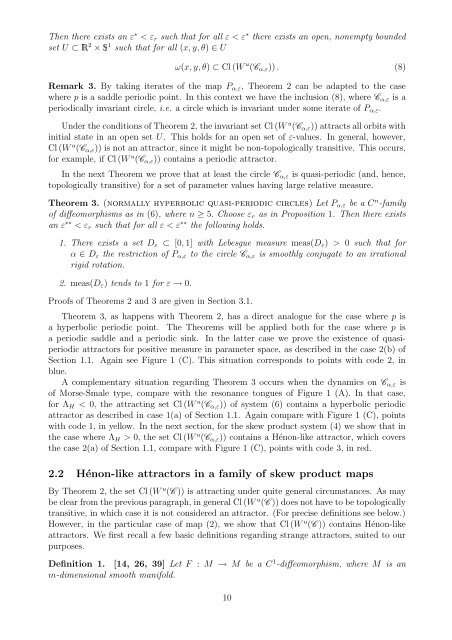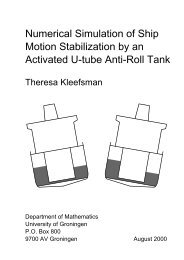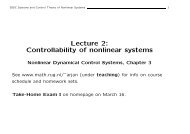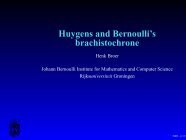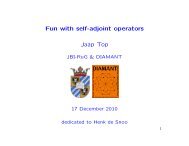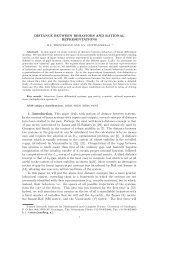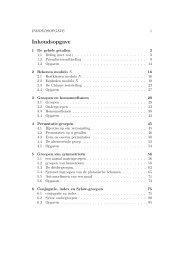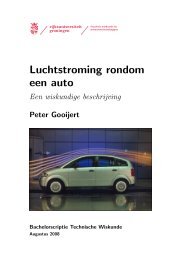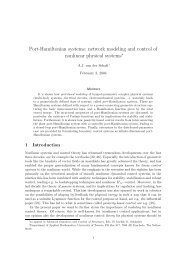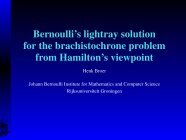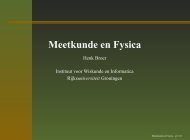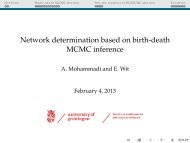Chaos and quasi-periodicity in diffeomorphisms of the solid torus
Chaos and quasi-periodicity in diffeomorphisms of the solid torus
Chaos and quasi-periodicity in diffeomorphisms of the solid torus
Create successful ePaper yourself
Turn your PDF publications into a flip-book with our unique Google optimized e-Paper software.
Then <strong>the</strong>re exists an ε ∗ < ε r such that for all ε < ε ∗ <strong>the</strong>re exists an open, nonempty bounded<br />
set U ⊂<br />
2 × ¡ 1 such that for all (x, y, θ) ∈ U<br />
ω(x, y, θ) ⊂ Cl (W u (C α,ε )) . (8)<br />
Remark 3. By tak<strong>in</strong>g iterates <strong>of</strong> <strong>the</strong> map P α,ε , Theorem 2 can be adapted to <strong>the</strong> case<br />
where p is a saddle periodic po<strong>in</strong>t. In this context we have <strong>the</strong> <strong>in</strong>clusion (8), where C α,ε is a<br />
periodically <strong>in</strong>variant circle, i.e. a circle which is <strong>in</strong>variant under some iterate <strong>of</strong> P α,ε .<br />
Under <strong>the</strong> conditions <strong>of</strong> Theorem 2, <strong>the</strong> <strong>in</strong>variant set Cl (W u (C α,ε )) attracts all orbits with<br />
<strong>in</strong>itial state <strong>in</strong> an open set U. This holds for an open set <strong>of</strong> ε-values. In general, however,<br />
Cl (W u (C α,ε )) is not an attractor, s<strong>in</strong>ce it might be non-topologically transitive. This occurs,<br />
for example, if Cl (W u (C α,ε )) conta<strong>in</strong>s a periodic attractor.<br />
In <strong>the</strong> next Theorem we prove that at least <strong>the</strong> circle C α,ε is <strong>quasi</strong>-periodic (<strong>and</strong>, hence,<br />
topologically transitive) for a set <strong>of</strong> parameter values hav<strong>in</strong>g large relative measure.<br />
Theorem 3. (normally hyperbolic <strong>quasi</strong>-periodic circles) Let P α,ε be a C n -family<br />
<strong>of</strong> <strong>diffeomorphisms</strong> as <strong>in</strong> (6), where n ≥ 5. Choose ε r as <strong>in</strong> Proposition 1. Then <strong>the</strong>re exists<br />
an ε ∗∗ < ε r such that for all ε < ε ∗∗ <strong>the</strong> follow<strong>in</strong>g holds.<br />
1. There exists a set D ε ⊂ [0, 1] with Lebesgue measure meas(D ε ) > 0 such that for<br />
α ∈ D ε <strong>the</strong> restriction <strong>of</strong> P α,ε to <strong>the</strong> circle C α,ε is smoothly conjugate to an irrational<br />
rigid rotation.<br />
2. meas(D ε ) tends to 1 for ε → 0.<br />
Pro<strong>of</strong>s <strong>of</strong> Theorems 2 <strong>and</strong> 3 are given <strong>in</strong> Section 3.1.<br />
Theorem 3, as happens with Theorem 2, has a direct analogue for <strong>the</strong> case where p is<br />
a hyperbolic periodic po<strong>in</strong>t. The Theorems will be applied both for <strong>the</strong> case where p is<br />
a periodic saddle <strong>and</strong> a periodic s<strong>in</strong>k. In <strong>the</strong> latter case we prove <strong>the</strong> existence <strong>of</strong> <strong>quasi</strong>periodic<br />
attractors for positive measure <strong>in</strong> parameter space, as described <strong>in</strong> <strong>the</strong> case 2(b) <strong>of</strong><br />
Section 1.1. Aga<strong>in</strong> see Figure 1 (C). This situation corresponds to po<strong>in</strong>ts with code 2, <strong>in</strong><br />
blue.<br />
A complementary situation regard<strong>in</strong>g Theorem 3 occurs when <strong>the</strong> dynamics on C α,ε is<br />
<strong>of</strong> Morse-Smale type, compare with <strong>the</strong> resonance tongues <strong>of</strong> Figure 1 (A). In that case,<br />
for Λ H < 0, <strong>the</strong> attract<strong>in</strong>g set Cl (W u (C α,ε )) <strong>of</strong> system (6) conta<strong>in</strong>s a hyperbolic periodic<br />
attractor as described <strong>in</strong> case 1(a) <strong>of</strong> Section 1.1. Aga<strong>in</strong> compare with Figure 1 (C), po<strong>in</strong>ts<br />
with code 1, <strong>in</strong> yellow. In <strong>the</strong> next section, for <strong>the</strong> skew product system (4) we show that <strong>in</strong><br />
<strong>the</strong> case where Λ H > 0, <strong>the</strong> set Cl (W u (C α,ε )) conta<strong>in</strong>s a Hénon-like attractor, which covers<br />
<strong>the</strong> case 2(a) <strong>of</strong> Section 1.1, compare with Figure 1 (C), po<strong>in</strong>ts with code 3, <strong>in</strong> red.<br />
2.2 Hénon-like attractors <strong>in</strong> a family <strong>of</strong> skew product maps<br />
By Theorem 2, <strong>the</strong> set Cl (W u (C )) is attract<strong>in</strong>g under quite general circumstances. As may<br />
be clear from <strong>the</strong> previous paragraph, <strong>in</strong> general Cl (W u (C )) does not have to be topologically<br />
transitive, <strong>in</strong> which case it is not considered an attractor. (For precise def<strong>in</strong>itions see below.)<br />
However, <strong>in</strong> <strong>the</strong> particular case <strong>of</strong> map (2), we show that Cl (W u (C )) conta<strong>in</strong>s Hénon-like<br />
attractors. We first recall a few basic def<strong>in</strong>itions regard<strong>in</strong>g strange attractors, suited to our<br />
purposes.<br />
Def<strong>in</strong>ition 1. [14, 26, 39] Let F : M → M be a C 1 -diffeomorphism, where M is an<br />
m-dimensional smooth manifold.<br />
10


